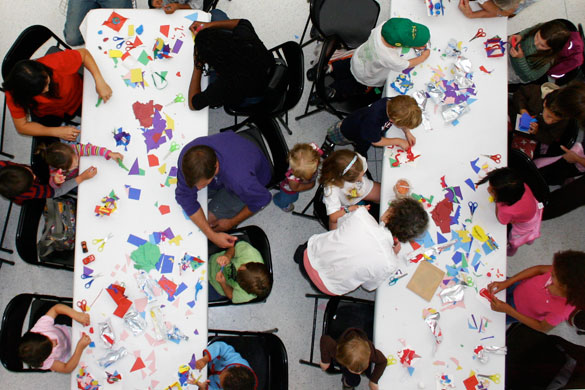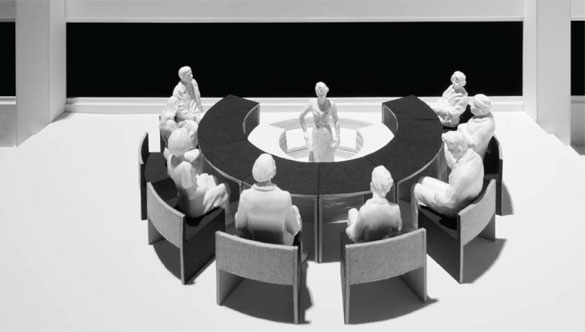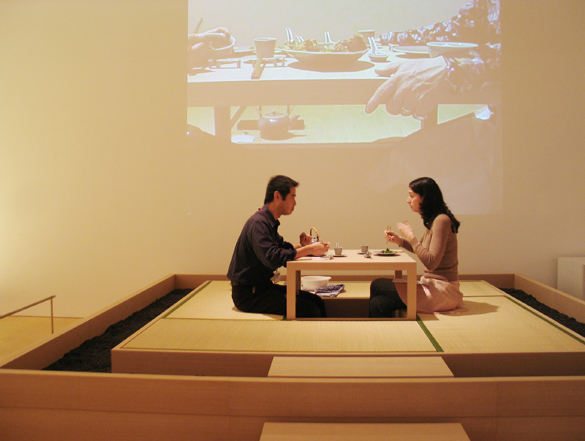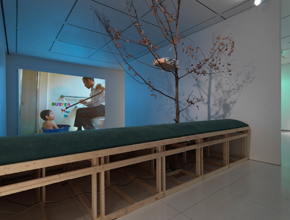C.J. Lind: January 2012 Archives

By Breck Furnas
Education Program Coordinator, Smart Museum of Art
Preparing a meal and sharing it with family was how my great-grandmother maintained bonds with those closest to her. She was born into a large family of laborers in rural Kentucky where one of the only opportunities to communicate and show affection to loved ones was at the dining table. Her homemade biscuits, bread, and jams bore the signs of her love as well as a lifetime of hardship. Nothing went to waste. Her creativity was sparked the most when she had the least.
I was fortunate enough to be the beneficiary of many inventions -- not limited to just food -- being raised by my great-grandmother. Not everything was a success. I distinctly remember once eating cookies made with stale Fruity Pebbles, but I miss those strange failures as much as her delicious pies.
Developing and managing family programs at the Smart the past year and a half has allowed me to tap into her skill set -- making connections between seemingly disparate concepts for the enjoyment (hopefully) and education of others. There's always a bit of a challenge in effectively relaying information from heavily researched and scholarly exhibitions to a five-year old, but believe you me their observations will give you plenty food for thought. For the Family Day tied to Feast, I've worked closely with John Harness, Education Intern, in thinking through the art activity in our lobby (we also have performance and visual art workshops, gallery activities, etc.):
BF: I think it was your idea to do a still-life collage, right?
JH: Right. We try to make direct connections to specific art pieces in our collection for all the programs we do, and the photographs of food and dinner tables by Laura Letinsky that will appear in Feast really stood out as something we could approach with kids. It's hard to do photography in this sort of setting, but I thought we could touch upon things like color, shape, and composition (which are so central to Letinsky's work) through the more kid-friendly medium of collage.
After all, kids everyone loves glue-sticks.
BF: Yeah, we've done photography workshops in small groups, but it demands a structure that's not possible with around 100 family members in the lobby of the Museum. Considering not only the artwork but the themes of sharing and mutual exchange in the exhibition, I wanted to connect (as I try to with all family programs) the "Four C's of 21st Century Education": creativity (creating new ideas, refining and evaluating ideas, etc.), collaboration (being open to diverse perspectives,viewing failure as part of the process, etc.), critical thinking (making complex choices and decisions, understanding the interconnections of systems, identifying and asking important questions that lead to better solutions, etc.), and communication (articulating ideas clearly and effectively).
I wanted to think of a way to bring the still-life into this contemporary educational practice -- through something communal. The kids create shapes or silhouettes of food for themselves and others to use. They'll be encouraged to think about their memories of favorite shared meals or what they like to eat with their families.
JH: It's always challenging to get the kids to share; I'm sure no one reading this will surprised by that! As you've just mentioned, riffing on the idea of radical hospitality, we especially want to emphasize collaboration and sharing for the Feast family activity. We haven't got the kinks worked out of this plan yet, but the idea is to get the kids to share a limited supply of materials so that they will have to consider reusing and re-purposing what they might otherwise think of as someone else's scraps. (Usually each participant gets a "new, clean sheet of paper," so to speak. Not so in February!) Obviously there are important messages about environmentalism and recycling that can be read into this as well, and I hope kids will pick up on that. Maybe I'll be able to get a few of the kids to start making cut-outs specifically for others to use, but they can often be pretty protective of "their" creations. So, I'll have to see how that plays out.
BF: I think you said the phrase "economy of paper" at some point. Kids can go to great lengths to safeguard what they feel is their personal possession. They also can sometimes have an eye for the prized possessions of others. Sharing (and by extension collaboration) is a huge lesson for our typical age group (4-7 years). They'll be encouraged to help others by donating some cut-out images if they choose to take any of the communal cut-out images out of a shared bin. Art education offers so many levels of instruction (and life lessons)!
Do you know what would be in your collage? Any favorite family meal?
JH: Hah. Well, I'm torn. You and I have a lot in common because I've spent a lot of time with my grandmother and her amazing Southern cooking -- that whole side of the family is from Alabama and I'd love to make a collage with okra and green tomatoes and Grandma's funky plates from the '70s. On the other hand, my other grandmother came from a Wisconsin Norwegian background and there are a lot of great ethnic foods that we would always eat around this time of the year. We'd have things like weirdly-shaped cookies with names like krumkakes and sandbakkels and pepperkakens, and a huge flatbread called lefse. I'd love to make a collage with all those things.
Maybe I'd make some sort of Southern/Norwegian "fusion" and make a collage with lots of krumkakes filled with okra or lefse and kudzu leaves. Then it'd be something like a self-portrait, in a way. I think it could be really neat to hear kids talk about their families, especially if they are aware of their extended families and food traditions connected to their heritage.

Mary Ellen Carroll's Open Outcry -- a commission for Feast -- is the latest iteration of a long-running project in which she creates site-specific conversations around meals under the title Itinerant Gastronomy.
Open Outcry is a commodities-inspired five course lunch presented next week at the financial gallery at CME Group in the Chicago Board of Trade. The carefully selected guests -- including an economist, a trader, a sociologist, and others -- will eat and converse in a sculptural table designed by architect Simon Dance in a viewing room high above the active trading floor. The meal, the setting, and the seating are all intended to "catalyze useful conversation about the intersections of food, power, finance, policy, and art."
A video documenting the lunch and the tables themselves will be displayed at the Smart as part of Feast, beginning February 16.

By Angela Steinmetz
Head Registrar, Smart Museum of Art
For a museum collections manager or registrar, food in the galleries can pose some big problems. There is a reason most museums strictly ban food and beverages in their galleries, mainly due to the risk it poses to their collections. There is the obvious damage that may happen if food or drink is spilled directly onto artwork, but there is also the increased risk of pests (insects or vermin) that are attracted to food also being attracted to various parts of artwork -- and I'm not talking about appreciation of the art for its visual presence! Certain bugs find wood, paper and textiles very tasty and we try very hard to keep them away from the collections we want to preserve.
So, what happens when your whole exhibition revolves around art made of food?
For Feast, we are taking some extra precautions to make sure our art doesn't invite the wrong kind of audience. For instance, the fresh food used for Alison Knowles's Identical Lunch will be placed in a closed container in the gallery -- not out in the open -- so that it will be less of an attraction to any pests that may come in from the outside, and minimize the risk of elements of the meal accidentally spilling onto other artworks in the gallery.
Ana Prvacki's The Greeting Committee and participatory elements of Mella Jaarsma's I Eat You Eat Me will be presented in our lobby instead of the galleries because they involve guests consuming food. We will also segregate our Bernstein Gallery from the rest of the galleries at certain times in order to present Tom Marioni's The Act of Drinking Beer With Friends is the Highest Form of Art. There will be several events over the run of the show where the gallery will become an active bar with patrons taking part in the work by drinking beer.
One of the most challenging pieces in terms of keeping the pests out will be Lee Mingwei's The Dining Project. The artist will be serving meals to a select few individuals during the run of the exhibition in the gallery space. We don't want any crumbs or left-overs to attract pests, so we will be performing thorough cleanings of the area after the meals take place, and will be continuously monitoring the space with small bug traps so that we can address any issues that may arise.
 The Dining Project also incorporates 270 pounds of dried black beans into its large platform -- yes that's a lot of beans! Before the beans even enter the galleries we will need to make sure they don't contain any bugs. This can be done by "cooking" the dry beans at a low temperature in an oven, or alternatively the bugs can be killed by freezing and thawing the beans over several weeks. The freezing trick is often used by museum professionals to control bug infestations (it is usually less damaging to objects than heat), but the Smart has utilized the faster heating method for contemporary projects where the materials end up being discarded after the exhibition. The full-sized tree used in Guy Ben-Ner's Wild Boy, shown in the Smart's presentation of Adaptation in 2008, was heat treated in an industrial wood kiln in order to make sure that it did not contain any art-eating bugs, and was also safe for the public to touch.
The Dining Project also incorporates 270 pounds of dried black beans into its large platform -- yes that's a lot of beans! Before the beans even enter the galleries we will need to make sure they don't contain any bugs. This can be done by "cooking" the dry beans at a low temperature in an oven, or alternatively the bugs can be killed by freezing and thawing the beans over several weeks. The freezing trick is often used by museum professionals to control bug infestations (it is usually less damaging to objects than heat), but the Smart has utilized the faster heating method for contemporary projects where the materials end up being discarded after the exhibition. The full-sized tree used in Guy Ben-Ner's Wild Boy, shown in the Smart's presentation of Adaptation in 2008, was heat treated in an industrial wood kiln in order to make sure that it did not contain any art-eating bugs, and was also safe for the public to touch. The museum is taking extra precautions for the artwork that will be presented in Feast, but museums all over battle with pests daily in their work to preserve art and artifacts for future generations. Most museums practice some form of Integrated Pest Management (IPM) in order to safeguard their collections -- ranging from pest monitoring and special cleaning schedules, to the ever-present no food and drink policy.
So the next time you want to bring your coffee into the museum but find yourself staring at a "no food and drink" sign, don't be disappointed. Take some pride in knowing that you are helping to protect the museum's collections from damaging pests instead!
Top: Lee Mingwei, The Dining Project, 1998, documentary photo of performance at the Whitney Museum of Art. Courtesy of the artist and Lombard-Fried Projects.
Above: The tree used for the Smart's 2008 presentation of Guy Ben-Ner's Wild Boy was heat treated to make sure it was pest-free.